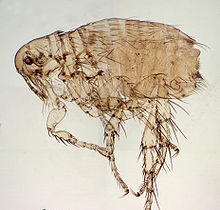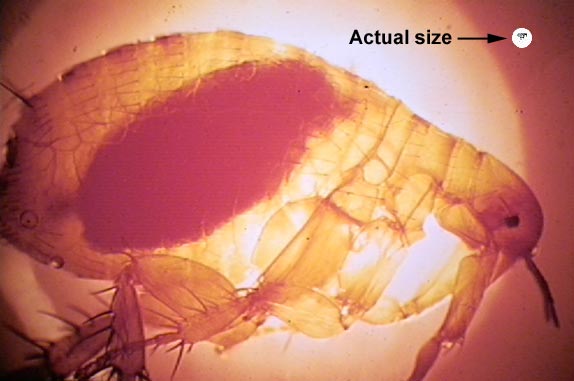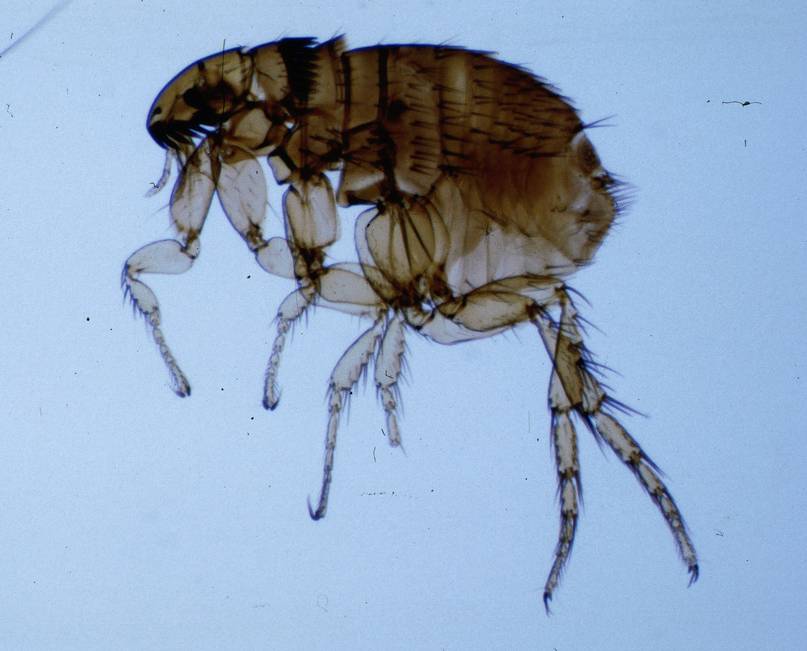All Fleas Annoy, But Some Kill
When fleas bite on humans, they leave behind a string of little, annoyingly itchy red welts. If they are itchy enough, the human scratches the welts, which can lead to added soreness and swelling.
If the human breaks the skin while scratching, it can cause infection, not to mention an allergic reaction in some people. This is the typical cycle of the fleabite.
Oriental Rat and Cat Fleas
Both the Cat Flea and Oriental Rat Flea (see photos below, labeled as such) are known disease carriers and they transmit diseases via bites and feces.
This is what makes broken skin around fleabites so dangerous, especially for people who don’t have the ability to wash their hands often, and for those who live in certain parts of the United States.
Although any flea can carry and transmit diseases, the Oriental rat flea is best known for its powers of human disease transmission.
In fact, the Oriental Rat Flea is the single most prolific carrier of a variety of diseases, but especially of the Plague.
On the other hand, the Cat Flea is known to transmit typhus, toxoplasmosis (aka Cat Scratch Fever), and other diseases.
Oriental rat fleas are found all over the world, but you can find them most often where there are large rat populations, since they prefer to feed on rats.
This includes the southern and southwestern United States, big inner cities such as New York City, Philadelphia, and Los Angeles, as well as the epicenter of Asian and African plague epidemics, according to the CDC. Essentially, you will find this flea anywhere you find rats in large numbers.
How Fleas Transmit Diseases
Did you know that fleas have saliva? Most people wouldn’t think about a flea having saliva – especially since the parasite is so small – but they do.
Did you know fleabites can kill? This is especially true after the fleas bite other animals that are sick, such as rats, and then bite humans. This is how the plague is transmitted in the U.S., and across the world.
The real problem is that both the Oriental and Cat fleas transmit bacteria, parasites and viruses to humans and pets via their saliva during each bite, and what is worse is that the fleas’ parasites usually carry their own diseases, viruses and bacteria.
The fleas’ parasites make themselves at home inside the flea-bitten human or pet, and then transmit its own viruses and bacteria via its own bites.
While the transmission of parasites, bacteria and viruses is the most prevalent cause of infection in the area of the fleabite, this isn’t the only result of the bite and transmission of the bacteria, viruses and parasites.
The Real Problem with Fleabites
In fact, some of the diseases that fleas carry can be deadly to some people, while not affecting other people at all.
This is why it is so important to prevent flea infestations in the first place. If an infestation still occurs despite the prevention measures taken, getting rid of the fleas should be your first priority.
The more fleas that make themselves at home in your home, the bigger the chance is that the fleas could be carrying a disease that it will transmit to you or your pets. Using some of the prevention techniques we talked about in previous posts can help, as can our previous posts about prevent fleabites on humans and pets.
Stay tuned for our next article in which we will cover some of the diseases that Oriental Rat fleas and Cat fleas carry and transmit, how the fleas get infected, and how to tell if you’re infected.
Have you ever gotten an infection from a fleabite? Let us know in the comments!



